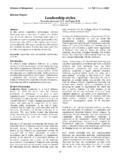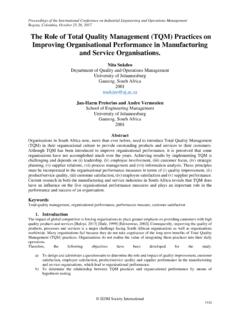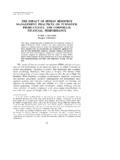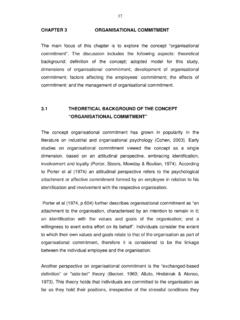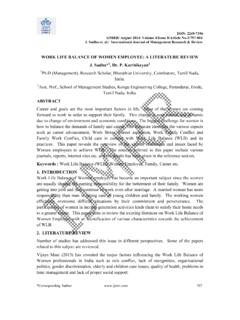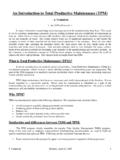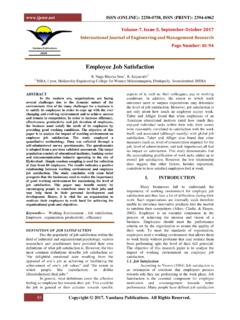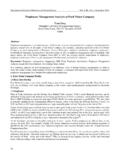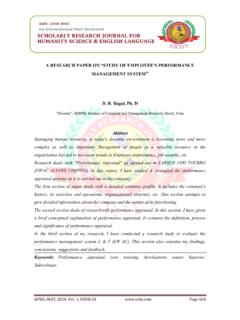Transcription of CROSS-CULTURAL MANAGEMENT OF A MULTINATIONAL …
1 International Journal of Business and MANAGEMENT Studies,CD-ROM. ISSN: 2158-1479 :: 1(3):379 390 (2012) CROSS-CULTURAL MANAGEMENT OF A MULTINATIONAL ENTERPRISE: A CASE STUDY OF THAILAND AND VIETNAM Sakda Siriphattrasophon Khon Kaen University, Thailand Managing effectively across national and cultural boundaries is a key success factor in international business in the context of globalization. The purpose of this empirical research is to compare the outcomes of the CROSS-CULTURAL MANAGEMENT of a renowned MULTINATIONAL organization from a Western region that has succeeded in its operations both in Thailand and Vietnam, as well as to examine the relationship between organizational antecedent factors and the outcomes of CROSS-CULTURAL MANAGEMENT . Survey questionnaire data were collected from April to September 2011 from the company s employees, who were voluntary full-time staff members across divisions in each country.
2 The survey included measures of job satisfaction , organizational commitment , and employee engagement and their antecedents. The results indicated that the level of employee engagement of employees in Vietnam was statistically higher than that of employees in Thailand, whereas there was a similar level of job satisfaction and organizational commitment of the company s employees in both subsidiaries. Furthermore, the regression analysis revealed that training and development, employee participation, job security, and collectivist culture predicted employee engagement. As a result, this study addresses managers that have to pay attention to build employee engagement in foreign operations. When employees are actively engaged in their organizations, they will be dedicated to their jobs and enjoy working in a team environment, and this will eventually reward good business performance.
3 Keywords: CROSS-CULTURAL MANAGEMENT , employee engagement, MULTINATIONAL company Introduction Globalization has increased the growing integration of the world economy from the business activities of countless international firms. Advances in technology and falling barriers in trade and investment, as main forces driving globalization, have increased the ease and speed with which companies can manage far-flung operations. These forces have made the cost of international business affordable for all types of firms. Consequently, MULTINATIONAL corporations are currently facing more intense pressure from competition and are compelled to respond to global challenges. Many firms proactively pursue internationalization as a strategic move. However, even though expanding internationally can be attractive and lucrative, operating and managing an international business has become more complex in today s business world due to several factors, which include differences in economic, cultural, legal, and political environments.
4 Internationalizing firms are routinely exposed to four types of risks: CROSS-CULTURAL risks, country or political risks, currency risks, and commercial risks (Cavusgil et al., 2008). Hence, investing and running business overseas involves more risk than undertaking domestic 379380 Sakda Siriphattrasophonbusiness. Among all international business risks, CROSS-CULTURAL discrepancies are inevitable in particular because human resources are required at all operational levels and across all business units. Therefore, there is a need to manage effectively the cross-culture aspect of human resources for the success of international organizations. According to Gancel et al. (2002), the failure of CROSS-CULTURAL MANAGEMENT stems from a number of reasons: insufficient CROSS-CULTURAL awareness managers that are not aware of the very existence of the cultural dimension of MANAGEMENT ; insufficient understanding managers know about the existence of culture, but they do not understand this issue and thus underestimate the impact that culture can have on business and do not have any need to deal with it; insufficient willingness managers knowingly decided not to deal with culture; and insufficient level of abilities and skills managers may be aware of and may even try to manage the culture but fail due to a lack of intercultural competence.
5 Many scholars finally conclude that effective CROSS-CULTURAL MANAGEMENT can become a critical source for increasing business competitiveness, which in turn can lead to success in international business. MULTINATIONAL companies have played an important role in international business. As defined by Cavusgil et al. (2008), a MULTINATIONAL enterprise is a large company with substantial resources that performs various business activities through a network of subsidiaries and affiliates located in multiple countries. The main reason for the expansion of MULTINATIONAL companies is to create global competitiveness by reducing production costs and exploiting market opportunities offered by trade liberalization and economic integration. The growing role of MULTINATIONAL firms has increased the volume of international trading and has stimulated businesses to become more competitive in the global market.
6 Besides, the emergence of multination corporations has also increased the degree of global interdependence. International business requires special knowledge, commitment of resources, and considerable time to develop the success of foreign operations. Being large organizations, MULTINATIONAL enterprises are not constrained by limited financial or human resources. Hence, this research places substantial emphasis on the case study of a leading MULTINATIONAL enterprise producing and distributing consumer products from a Western region that has successfully expanded across national borders. The company has been able to create a competitive advantage to outperform its competitors, both locally and internationally, by managing effectively human resources across national and cultural boundaries. This MULTINATIONAL firm has been also expanding its operations into Thailand and Vietnam over the past decades.
7 Learning from the study of a well-performed MULTINATIONAL organization not only advances knowledge in the field of CROSS-CULTURAL MANAGEMENT as for businesses that are considering entering emerging markets, particular in Thailand and Vietnam. Literature Review CROSS-CULTURAL MANAGEMENT is obviously important and has a great effect on the success of overseas business operations. Cullen and Parvoteeah (2008) have reported that international business MANAGEMENT is inseparable from the sphere of patterned cultural behaviors because culture is represented in terms of the pervasive and shared beliefs, norms, values, and symbols that guide the everyday life of different groups of people. International managers have to decide to choose and adjust their strategies aligned with each country s culture. Appropriate business strategies can be used to reduce possible risks and impacts, of CROSS-CULTURAL discrepancy and deliver successful outcomes for their own enterprises.
8 CROSS-CULTURAL MANAGEMENT of a MULTINATIONAL to Cullen and Parboteeah (2008), culture can be generally classified into three major levels: (i) National Culture - the dominant culture within the political boundaries of the nation-state; (ii) Business culture the norms, values, and beliefs that pertain to business in a culture ( acceptable ways to conduct business in a society); and (iii) occupational and organizational culture. Occupational culture refers to the norms, values, beliefs, and expected ways of behaving for people in the same occupational group, while organizational culture is the set of important understandings that members of an organization share. All of the levels of CROSS-CULTURAL differences affect all interactions of business as well as business performance. Smith et al. (2008) presents a conceptual framework on the factors affecting cross-country differences.
9 This framework is associated with economic development, political/social history, and national cultures (norms, values, and beliefs), which has a powerful influence on social norms and the role of an organization, as well as social character traits (values, role definitions, motivations, and perceptions). These have influenced organizational citizenship behavior (OCB) and have had an important impact on organizational outcomes such as organizational performance, team performance, and individual performance ratings. In the meantime, moreover, there are several antecedents that also affect OCB, such as organizational contexts, attitudes, etc. Outcomes of CROSS-CULTURAL MANAGEMENT The evaluation framework of organizational outcomes has been developed according to various approaches. For instance, organizational effectiveness has been considered as an organization that achieves its short-term goals/ends and/or long-term goals with accomplishment of the required or an above-standard of organization.
10 As a consequence, evaluations should focus on many aspects of an organization and its processes, for example, its finance and employee satisfaction (Cameron, 2005). A number of studies, in addition, have also clearly shown that organizational commitment and employee engagement are closely associated with the effectiveness and business performance of organizations (Meyer and Allen, 1997; Saks, 2006; Wagner and Harter, 2006; Hackman and Oldham, 1980). These critical factors can be used to reflect the outcomes for organizational MANAGEMENT and key success indicators of firms. employee or job satisfaction is defined as employees positive attitude towards their job and overall work situation which results from perception and other assessments. This satisfaction is motivated by task fulfillment and the goal achievement of the organization (Hackman and Oldham, 1980).

